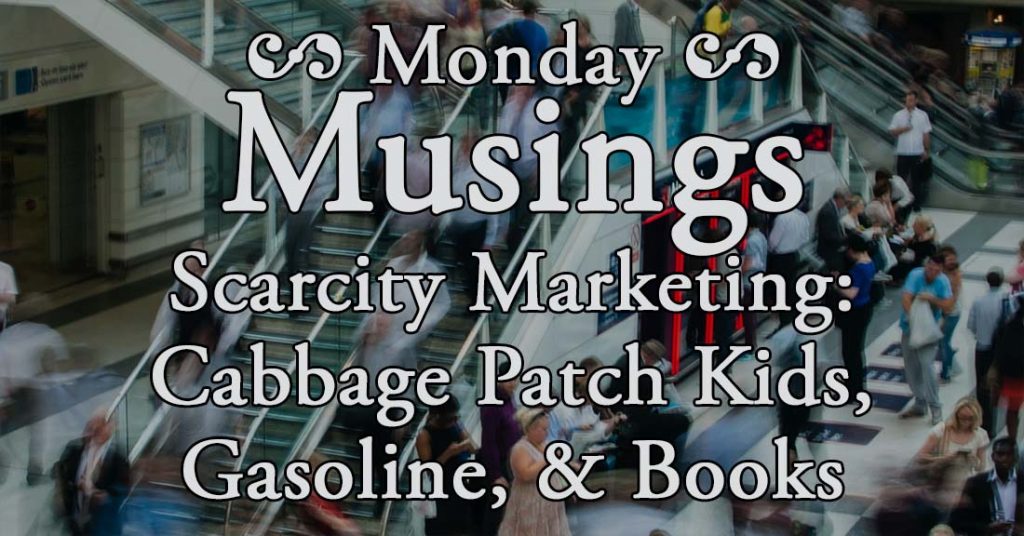Share This Musing
Scarcity Marketing: Cabbage Patch Kids, Gasoline, & Books
Have you seen a news report urging you to order your Christmas gifts early because supply shortages are expected? How about those UK drivers waiting in long lines to buy gas? Did you know book suppliers are warning bookstores that this year’s hottest sellers might not be available? Do you remember the Cabbage Patch Kids craze?
Are these shortages real or is scarcity marketing at work?
Cabbage Patch Kids
Back in 1983, the hottest Christmas toy was a simple doll, not all that different than dolls that had been around for years.
In fact, the Cabbage Patch dolls themselves had been around for years, though not called that. Martha Nelson Thomas had been making Doll Babies since the early 1970’s and selling them at arts and craft shows. In 1976, she sold some to Xavier Roberts for him to resell in Georgia. Later, he created his own doll marketed as Little People. In 1982, he licensed the idea to Coleco who rebranded the dolls as Cabbage Patch Kids (following the old story that babies came from the cabbage patch).
So why did the doll suddenly become the must-have toy of Christmas 1983?
The dolls were unique for several reasons. Unlike many of the competitors, they didn’t “do” anything. They were simple, stuffed dolls which appealed to parents’ and grandparents’ nostalgia. The dolls were “adopted” as opposed to being sold (at least in marketing lingo).
Most importantly, each doll was unique. Sure, it was a mass-produced toy by 1983, no longer hand-crafted by Thomas, but it still came with different combinations of hair, eye and skin color and its own name. The odds that a child would find a friend with the exact same doll was minimal.
Thus, the company was utilizing scarcity marketing. They deny they intended more, but it went further.
What is Scarcity Marketing?
Even if you avoided all economics classes, you’ve probably heard of the law of supply and demand. In concise terms, the price of a product will adjust until the volume of supply equals demand. Why? If the price increases, more people may be willing to sell (supply), but less people will be willing to buy (demand). Thus, too much supply will drive the price back down.
So how do you keep the price high? You have to shift the demand curve (i.e., increase actual demand, not just move demand up or down with price) or shift the supply curve (i.e., decrease supply).
Constricting supply can be easy in a monopoly market or with collusion. OPEC demonstrated that in the 1970’s with their control of the oil market. The diamond industry thrives with their tight control of supply.
Moving demand, however, can be more challenging. One method to do that is to stir up demand by appealing to a potential buyer’s emotions. Scarcity marketing (think fear of missing out) is a highly effective tool. It’s why you see “Limit Three Per Customer” or “Introductory Price” or “Order Now For Guaranteed Delivery.” If a consumer thinks they can’t have something, they want it more.
One of the best tools to create the image of a scarcity is through the mass media.
Gasoline Shortages
The United Kingdom, like many countries, is suffering from an insufficient number of truck drivers. Without transportation, a backlog of deliveries has hit a number of industries. BP announced that it would be temporarily closing “a handful” of gas stations because they couldn’t get fuel. Esso said “a small number” of stations were affected as well. Other major retailers said they weren’t having issues, but it didn’t matter.
The media picked up the story and UK drivers rushed to fuel their cars. Gas stations that had plenty of fuel to handle normal demand couldn’t keep up and the number of shortages increased. When the media reported those additional shortages, the crisis amplified.
The UK government has repeatedly clarified that the country has plenty of fuel, but has had to mobilize the military to deliver fuel to meet the increased demand. And, yes, prices have increased.
Living in the Southeasten U.S., I’m quite familiar with unintentional scarcity marketing’s impact on gasoline. When hurricanes shut down the refineries in the gulf region or when the Colonial Pipeline closes for any reason, we have plenty of stored fuel in huge tank farms to meet normal demand for weeks. What we can’t handle, though, is a sudden influx of car owners racing to fuel up.
Even knowing it is a psychological shortage, not a real shortage, doesn’t make me immune. The day before Hurricane Ida hit, we fueled our cars. As predictable as ever, the shortages started two days later.
Cabbage Patch Craziness
So back to our cute little dolls of 1983. Coleco arranged for a mass adoption of Cabbage Patch Kids by local schoolchildren at the Boston’s Children Museum, all dutifully broadcast by the local media and picked up as a national news “feel good” story. They sent dolls to media outlets across the nation with huge success. The Today Show had a five-minute spot dedicated to the toy. Coleco had a hit on its hands.
Too much of one. By the first week of October, they had sold all two million of the dolls they had manufactured. Media began showing video of shoppers crowding into stores demanding the toys. Fights broke out and were captured on film. If YouTube had been invented, it would have racked up millions of view. Instead, the scenes were broadcast on both local and national news.
Coleco kicked their Chinese factories into high gear and shipped as fast as they could, but they couldn’t meet the unexpected demand. The blackmarket took off. Prices skyrocketed to ridiculous levels.
Intentional Or Not?
Toy retailers guess each year what will catch the attention of children (and their parents). Some are genuinely caught off guard when a toy sells at far greater volume than expected. With long lead times from Chinese manufacturers, they often can’t get the product into the stores fast enough and end up missing opportunities.
Others, however, try to create the image of a shortage. They will run an advertisement for a toy (supplies limited!) at a particular store, make sure the media is there to capture images, and then purposely sell out of their inventory. The media falls for it and talks about the “hottest craze parents can’t buy.” The story goes national. Shortages pop up everywhere. Magically, though, enough supplies flood out of domestic warehouses to meet the demand.
This is Black Friday in a nutshell. Create limited items at a ridiculously low price and sell them at a weird hour. More people show up to claim the deal than can buy them. Fights break out. News story is created. Every single year.
And This Year?
With this knowledge—and all too many years in Corporate America—I might eye news stories about shortages and the need to order early for Christmas quite cynically. When I hear a certain toy is going to be scarce, I wonder if some warehouse is loaded down and some executive is sweating and hoping that the trick works again this year.
I also, however, don’t have any children who might disown me if they don’t find the toy they must—must—have under the Christmas tree, so I can afford to be a skeptical. The worst thing that might happen is I miss a craze. Not too many of those are aimed at us in the second half century of our lives.
Except, of course, for books.
What Does This Have To Do With Books?
Here’s the rub and the part I’m trying to figure out. Ingram Book Company, the world’s biggest book wholesale distributor (including my own novels), is warning stores that supply chain issues may affect their ability to supply retailers with the books to stock their shelves for the holiday season. They aren’t alone as other distributors have issued similar warnings.
Is it hype? I don’t think so.
Since book stores return unsold books to the distributors for full credit, there isn’t much incentive for distributors to oversell them. It means nothing unless the ultimate customer buys them. I haven’t seen any signs of scarcity marketing of books direct to the consumer.
It could be fun though. Maybe I get a video camera, a table, a stack of my books, and a group of people willing to fight over the “last” copy of the Liars’ Table. Can I get CNN to cover that?
Liars’ Table – Paperbacks Are Coming!
With the release date looming, pre-order sales for the ebook have been strong, but the number one question I’m getting is “What about the paperback?”
I promise, I promise, I promise – the paperback is coming. Like everything else, it’s caught in staffing shortages around the pandemic, but everyone is working hard to get it done.
Because of a quirk working with retailers, I can’t access pre-order sales with them for paperbacks (crazy, I know). We’re trying hard to have it ready to ship so that people can order and receive it by October 19. As soon as retailers start listing it on their sites, I will shout it as loud as I can.
And don’t worry about scarcity. I could only dream that the book sells faster than it can be delivered.
In the meantime, if you want to pre-order the ebook…

In country stores, old men gather over breakfast and coffee to swap tall tales. The fish are bigger, danger greater, and adventures wilder in the stories told at a Liars’ Table. No harm in stretching the truth when nothing exciting happens in their small town.
Until someone steals Purvis Webb’s car. Life is hard enough without thieves. A wife in a nursing home. An estranged daughter. A grandson he didn’t know existed.
When he finds his car and steals it back, he takes more than he intended. Evil men follow him back to his quiet Appalachian home. They do more than threaten violence. They expose the family’s lies that have been buried all these years.
Interesting Link
I have an annual pass to Masterclass primarily to listen to authors and other creatives, but I’ve started a new, highly entertaining course and want to share it with you.
Jesse Krebs is a former instructor for the US Air Force’s SERE, a program that teaches Airmen how to survive, evade, resist, and escape if their mission goes askew and they find themselves evading an enemy or surviving a hostile environment. After leaving the military, she became a back country mountain guide and ultimately founded and led the civilian SERE Training School. In her opening session on Masterclass, she emphasizes that she doesn’t focus on teaching long-term wilderness skills, but rather how to survive and escape if you find yourself lost or injured in the wilderness.
The information is fantastic, and Jesse’s positive and enthusiastic attitude makes her a perfect instructor. I highly recommend her course on Wilderness Survival. (Note: I am NOT an affiliate of Masterclass nor do I receive any compensation. I just find this class fun.)
Gratuitous Dog Picture

Poor Typhoon. No one respects the royalty that he knows he is. What has His Royal Highness Little Prince Typhoon Phooey’s fur ruffled today? The birds at the feeder are flapping their wings too loud and disturbing the royal nap. He expects much outpouring of sympathy for his rough life.
Support The Musings
Call it a tip. Or the euphemestic "Buy me a coffee." I prefer patronage. Generous patrons have supported artists throughout history. Whatever you want to call it, if you enjoyed this post, consider making a donation to help offset my costs. Your support will help keep my stories ad free.3 Comments
Leave a Comment
Monthly Reader Survey
Each month, I ask my readers a question or two. Sometimes, my questions are random fun things that have nothing to do with books. Other queries are about reading and writing. Join in the fun and answer this month's survey. The results (and a new survey) will be shared later in the month.
Monthly Reader Survey
Each month, I ask my readers a question or two. Sometimes, my questions are random fun things that have nothing to do with books. Other queries are about reading and writing. Join in the fun and answer this month's survey. The results (and a new survey) will be shared later in the month.


Isn’t it amazing how SUSPECTED(or real) shortages can affect the things we need-or just want?
Looking forward to the book for sure.
So sorry Prince Typhoon Phooey the BIRDS flapping their wings disturbed the royal nap!!
Typhoon’s expression looks like he’s thinking, “seriously!”
Waiting patiently for the book.. Ty is cute as usual. Interesting Musing this week – enjoyed it.